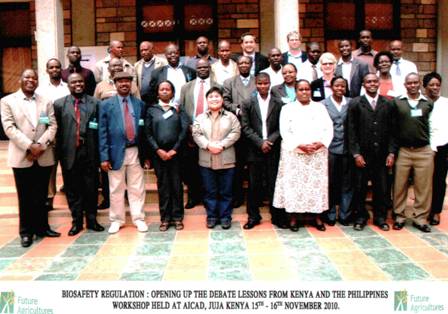 Background to the workshop
Background to the workshop
Debates about transgenic crops have become highly polarised across the globe. In the process, civil society organisations and social movements have played an important role, alongside governmental and ‘expert’ science institutions, in debates about agricultural biotechnology.
In developing countries, biosafety and its regulation has become the lightening rod for debates about transgenic crops. This focus on biosafety has tended to narrow national biotechnology debates to the control and management of a relatively narrow range of biophysical risks, rather than broader socio-economic and ethical concerns about, for example, which kinds of investment in the technologies should and should not be encouraged and pursued, and for what kinds of reasons, or about which kinds of risks, whether socio-economic or biophysical should be taken into account in managing the technologies, or about how the technologies should be deployed.
These dynamics at the national level reflect global efforts to harmonise national frameworks around an Organisation for Economic Co-operation and Development (OECD) ‘ideal’, seen as the benchmark for biosafety capacity building in developing countries. But is a uniform pattern of closure based on frameworks developed in such different circumstances a realistic or even desirable goal? Or should regulations be built from the bottom up, in response to local contexts and needs? This is an important concern, given the differences in regulatory reach and capacity between developing countries and a far from uniform interpretation of the OECD ‘ideal’ even among OECD countries themselves.
This project seeks to explore how debates about and beyond biosafety can be ‘opened up’. The focus is on Kenya and the Philippines – two countries that have been seen, at different times, as regional ‘test cases’ for biotechnology and biosafety regulatory development. In the Philippines, a national biosafety regulatory system, the first in the Association of Southeast Asian Nations (ASEAN) region, has been in place since 1990, the result of intense lobbying by national scientists. The National Biosafety Committee of the Philippines (NBCP) is still one of the few biotechnology regulatory bodies in the world that includes civil society representatives. However, increasing levels of scientific and regulatory complexity present new challenges, for state regulators and civil society actors alike. In Kenya, following a polarised debate that lasted several years, the country’s National Biosafety Bill (the third in Africa – after South Africa and Burkino Faso) became a law in February 2009 (Biosafety Act, 2009).
Nevertheless, many questions about implementation remain unanswered, particularly in relation to Kenya’s primary crop, maize, much of which is grown on small scale farms. Unlike in OECD countries, many Kenyan farmers plant own-saved or exchanged seed rather than buy commercially produced seeds. Given that maize is a cross-pollinated crop these are likely to be ‘composites’ rather than pure varieties. This has serious implications for biosafety regulation.
Key Links
- STEPS Centre: Beyond Biosafety: Opening up biosafety debates in Kenya and the Philippines
- Kenya’s National Biosafety Office (Kenya Biosafety Authority)
- African Biosafety Stakeholders Forum (ABSF): Kenya Biosafety Act 2009
Further Reading
- Ely, A. V. (2003) ‘Evaluation of Environmental Risks of Bt Maize in the US and EU: Lessons and Challenges for Kenya’ produced for the Institute of Development Studies, Brighton, UK
- Keeley, J. and Scoones, I. (2003), Contexts for Regulations: GMOs in Zimbabwe, IDS Working Paper 190, Biotechnology Policy Series 9. Brighton, UK: IDS
- Odame, H., Kameri-Mbote, P., and Wafula, D. (2003), Globalisation and the international governance of modern biotechnology: implications for food security in Kenya, IDS Working Paper 199, Biotechnology Policy Series 20. Brighton, UK: IDS
- Mwangi, P. and Ely, A. (2001) ‘Assessing risks and benefits: Bt maize in Kenya‘ Biotechnology and Development Monitor 48, 6-9
